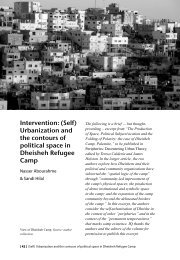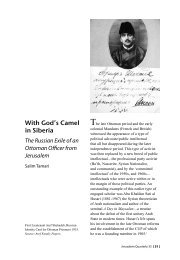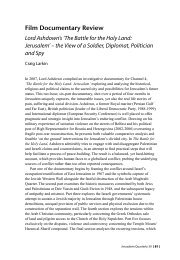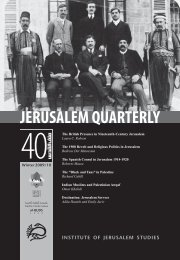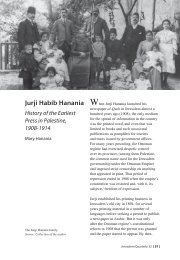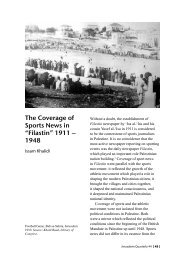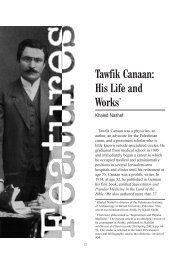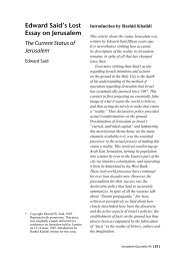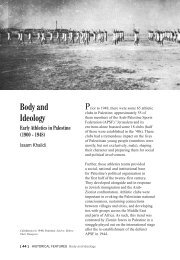PLUNDERING PALESTINE - Jerusalem Quarterly
PLUNDERING PALESTINE - Jerusalem Quarterly
PLUNDERING PALESTINE - Jerusalem Quarterly
You also want an ePaper? Increase the reach of your titles
YUMPU automatically turns print PDFs into web optimized ePapers that Google loves.
interiorly plastered walls that is most likely dated to the Roman period. Surrounding<br />
this structure were numerous mosaic floor remains. The preliminary interpretation<br />
of this area is that it could be a pool surrounded by several public buildings; further<br />
investigation is needed, however, to produce a more definitive interpretation.<br />
This initial survey of the potential danger to archaeological and cultural heritage in<br />
the Aboud region revealed several sites, such as Khalat al-Qadat and the water pool<br />
surrounded by mosaics, that had not been previously identified in archaeological<br />
surveys. The Wall threatens to isolate these sites and preclude their further investigation<br />
and analysis.<br />
Al-Jib (Ancient Gibeon)<br />
On 9 August, 2007 a team from PACE visited the excavation conducted by the Israeli<br />
Civil Administration in al-Jib to inspect the work, talk to the people of the village, and<br />
confront the excavation team. The excavations were taking place at a ruin known locally<br />
as Khirbet al-Sheikh, west of the village. The excavation team was made up of some<br />
40 Palestinian labourers and a young Israeli archaeologist who had graduated from the<br />
Hebrew University four years earlier. 10 He told us on condition of anonymity that he had<br />
been digging at the site for a month and a half, and was to continue to do so for another<br />
four to five weeks. At the same time, he was working on his Master’s thesis. No other<br />
professionals (a registrar, surveyor, photographer, or other professionals) were on the<br />
team, and he had to perform all of these tasks himself. The storage place of the finds was<br />
Mishor Adumim near <strong>Jerusalem</strong>, and he was to study them in the winter months.<br />
The archaeologist confirmed to us that he and the large team of Palestinian workers<br />
were working for the Israeli Civil Administration Department of Archaeology headed<br />
by Yitzhak Magen, who has served as the director of that department since 1981 under<br />
the title “Staff Officer of Archaeology in Judea and Samaria”. 11 This department,<br />
part of the military administration of the occupied territories, does not report to the<br />
Israel Antiquities Authority (IAA), which is the official Israeli body in charge of<br />
archaeological activities in Israel and occupied East <strong>Jerusalem</strong>. Its licensing policies,<br />
storage facilities and publications are all separate and independent.<br />
The director of the al-Jib excavation told us that the site was being surveyed in<br />
preparation for the construction of the Wall, which will eventually separate al-Jib<br />
from the Jewish settlement of Pisgat Zeev. No architectural remains and a few<br />
shards were discovered during the survey ; nevertheless, work on the Wall was<br />
stopped and an excavation carried out. He called this a “salvage excavation” and<br />
admitted that it could possibly affect the Wall’s final path. He also admitted that it<br />
was being financed by the Israeli Ministry of Defence. He did not view his work<br />
as political, however, referring to it as professional and even complaining from<br />
“vandalism” by the local population, particularly on the weekends and after working<br />
hours when there were no guards at the site.<br />
<strong>Jerusalem</strong> <strong>Quarterly</strong> 33 [ 49 ]


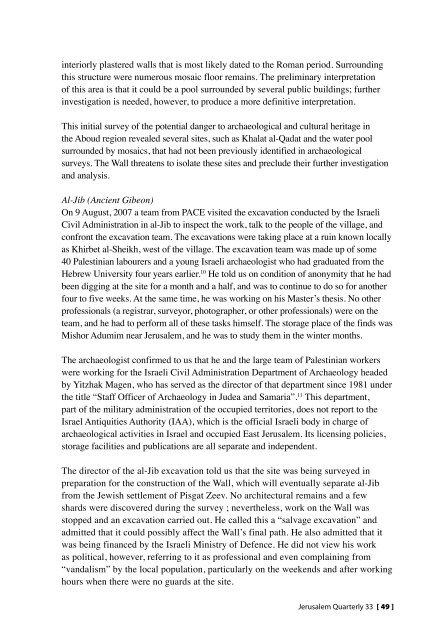
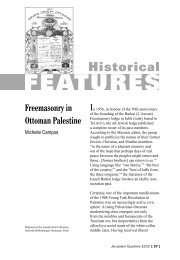
![In Search of Jerusalem Airport [pdf] - Jerusalem Quarterly](https://img.yumpu.com/49007736/1/180x260/in-search-of-jerusalem-airport-pdf-jerusalem-quarterly.jpg?quality=85)
